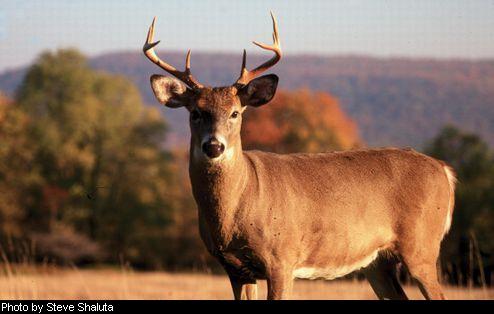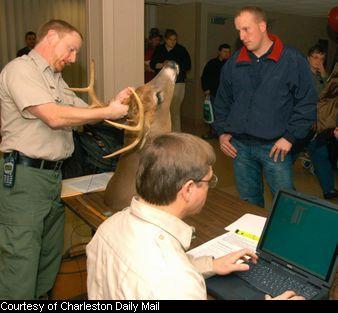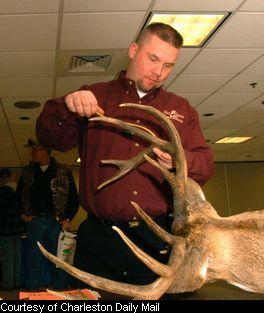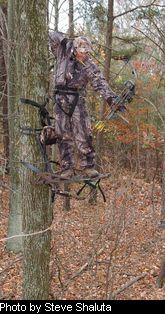
Keeping Score
By Gene Thorn
Taking a huge whitetail buck is the dream of most deer hunters.
When the dream finally comes true, what needs to be done to have
the antlers scored and entered into the record books? Record keeping
developed in North America as part of the conservation movement in
the early 20 th century.
Keeping records of big game animals is a way of recognizing exceptional
animals and the hunter. Even more importantly, the records provide
statistical data and insight into past and present management, health,
and trends of wildlife populations. The records are a testimonial
to the effectiveness of wildlife management and the importance of
hunting as a management tool.
Obtaining a clear photograph of the whole deer and hunter in a
field setting is worth the effort. Preserve this memory forever by
taking the time to get the best photo possible. Take a moment to
present the animal in a respectful manner with an appropriate background.
Care should be taken not to break any tines off or split the skullplate
between the antlers while dragging the deer out of the woods, while
loading and unloading it out of a vehicle, and while processing the
animal. The antlers with skullplate attached should be sawed off
by you or your taxidermist, leaving a generous portion around the
antler base area. If a European mount is desired, the skull needs
to be completely cleaned. Make sure to securely attach the game check
tag to the antlers. You will need to present it to the official measurer.
Rough Scoring Your Deer Antlers
A rough score may be obtained with a quarter-inch steel measuring
tape. This will help if you are unsure whether a deer rack should
be taken to an official measurer. Have a notepad ready to record
measurements to the nearest eighth inch.
1. Measure the inside spread of the main beams at the widest point.
2. Measure the length of the main beams on both sides. Start at
the burr from a side view and measure along the beam to the tip.
3. Measure the length of each point over an inch long from a point
that is in line with the top of the main beam to the tip of the point.
4. On both sides, measure the circumference (go around the antler
with the tape) of the main beam between the burr and the 1st point
at its smallest point. Measure likewise between the 1st and 2nd point,
between the 2nd and 3rd, and the 3rd and 4th point (if there is no
4th point, measure halfway between the 3rd point and tip).
Add up all these measurements and you have a rough gross score
for the rack. This does not include deductions for nonsymmetry, which
can be substantial. If the rack is nontypical, the scoring becomes
more complex. Scoring forms that have diagrams and will allow you
to “green” score your deer can be obtained from the Boone
and Crockett Club for a nominal fee.
WV Big Buck Contest and Record Keeping Program
West Virginia has a Big Buck Contest and record keeping program
administered by the Division of Natural Resources Wildlife Resources
Section and sponsored by the DNR, Izaak Walton League and West Virginia
Bowhunter’s Association. Any Boone and Crockett or Pope and
Young official scorer may measure for the Big Buck Contest. January
31, 2005 is the last day that deer can be entered for the 2004 contest.

Deer taken in previous years, however, can be scored at any time
and be eligible for a Certificate and entry into the Records. The
minimum score for entry of bow-killed bucks is 125 points for typical
racks or 155 for non-typical (Pope & Young). Gun-killed bucks
must score at least 140 points for typical racks or 165 for non-typical
(Boone & Crockett). The official scorer will determine whether
the deer will be entered in the typical or nontypical category. New
state records cannot be scored until at least 60 days after the kill.
There has been great interest in this program by West Virginia
hunters. Each year an increasing number of hunters are having deer
scored and entered in the Big Buck contest and Records. In cooperation
with an official measurer, the hunter must provide the following
items to the Big Buck Contest Review Committee for entry.
1. official score sheet signed by the measurer
2. official game check tag
3. field photos if available (mandatory for new state records)
4. fair chase affidavit signed by the hunter
Boone and Crockett Record Book
The first Boone and Crockett Record book titled “Record of
North American Big Game” was published in 1932. The Boone and
Crockett scoring system evolved into the measuring system adopted
in 1950 which emphasizes mass and symmetry. This is the same system
of scoring used today by official Boone & Crockett and Pope & Young
scorers, and the state Big Buck Contest.

Both gun and bow kills are eligible for entry into Boone & Crockett
Records after a 60-day drying period. Minimum entry scores for typical
whitetail deer are 160 for awards and 170 for the all-time record
book. Non-typicals must score at least 185 for awards and 195 for
the all-time record book.
In cooperation with an official Boone & Crockett scorer, the
hunter must provide the following items for entry.
1. official Boone and Crockett score sheet
2. fair chase statement signed by the hunter and measurer
3. three photos of the antlers with front, right and left views
4. $40 entry fee -- check made payable to Boone and Crockett Club
5. copy of the hunting license and game check tag
6. hunter, guide and hunt information sheet completed by the hunter
You can contact the Boone and Crockett Club through their website
at www.boone-crockett.org or by mail:
Boone and Crockett Club
250 Station Drive
Missoula MT 59801-2753
(406) 542-1888
(888) 840-4868 – Toll free order line for score sheet 
Pope and Young Record Book
The Pope and Young Club, a club which also has a rich hunting and
conservation heritage, is recognized as the official repository for
records of North American big game taken with a bow. A typical whitetail
deer must score at least 125 points for entry. A nontypical must
score a minimum of 155 points. Official measuring can only be done
after a 60-day drying period. The antlers and skullplate must be
air dried at room temperature and normal atmospheric humidity, in
an unaltered state (no repairs to broken antlers or skullplate).
If a rack is stored in a freezer, the drying period does not start
until it is taken out. Removal of past entries from the records and
disqualification of present and future entries may result from attempts
to mislead an official scorer. In cooperation with an official Pope & Young
measurer, the hunter must provide the following items for entry.
1. official Pope and Young scoring form completed and signed by
the measurer.
2. fair chase affidavit completed and signed by the hunter
3. three photographs of the antlers with front, right and left
views
4. field photos of the whole animal if available
5. $25 entry fee – check made payable to Pope and Young Club
You may contact the Pope and Young Club through their website at
www.pope-young.org or by mail:
Pope and Young Club
15 E. 2 nd Street
PO Box 548
Chatfield, MN 55923
(507) 867-4144
Getting an Entry in the Book
Take the needed items with you when you get an animal scored and
the official measurer will help you get the entry submitted. The
entry fees go into the Boone & Crockett or Pope & Young Club’s
Conservation Funds which pay for conservation education and wildlife
research projects.
Always make an appointment with the official measurer. The scoring
of a deer rack is a time-consuming process and is taken very seriously
by the measurer. This work is done as a public service on a voluntary
basis. Measurers receive no compensation from the hunter, Boone & Crockett
Club, or Pope & Young Club. Please be courteous and understand
that they have other duties.
Ten private individuals and 15 DNR employees located throughout
the state, are official measurers. DNR furnishes a staff of official
measurers for the West Virginia Hunting and Fishing Show, hosted
by the West Virginia Trophy Hunters Association, held at the Civic
Center in Charleston during the latter part of January each year.
Measurers also are set up at a number of other events during the
year.
If you have had your rack scored by an official measurer, do not
have it rescored by another measurer – a practice known as
score shopping. This practice, besides being a waste of precious
time and effort, is frowned upon by measurers and records committees.
If there is a problem or dispute with the measurements, take it back
to the original measurer and point out your concerns. The position
of the record books is that the lowest score is the official score
if it is measured by different scorers.
Getting a deer worthy of entry into a record book is quite an accomplishment
for a hunter. It can be gratifying to know that the record will be
there for future generations to see and enjoy. If you harvest such
a whitetail, contact an official measurer and have the antlers scored.
Gene Thorn is a wildlife biologist stationed at R.D. Bailey
WMA. |



